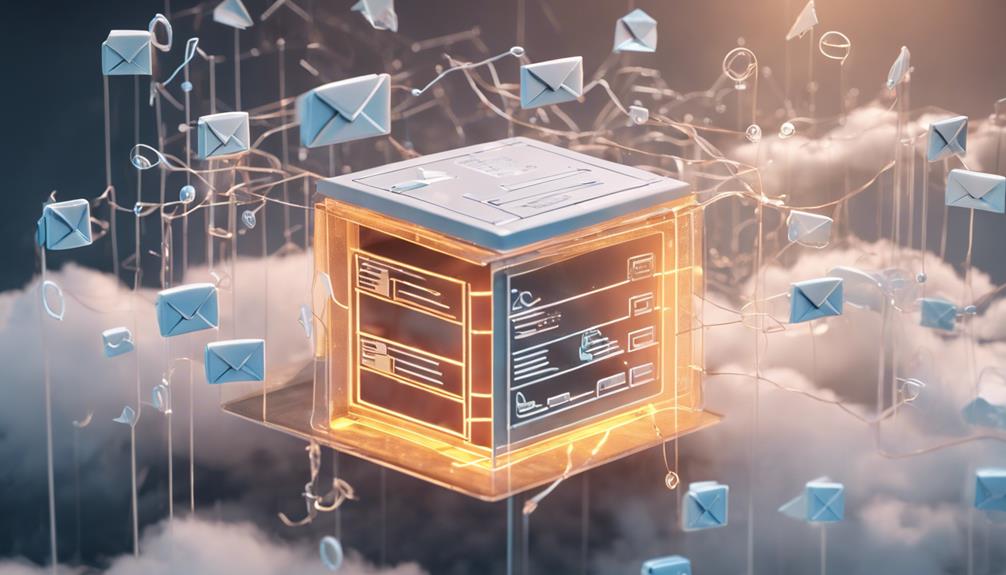
When you archive messages, they're moved out of your immediate inbox view and stored in a separate area designated for archived content. This digital storage acts like a personal vault, keeping your archived messages safe and accessible, analogous to storing valuable items in a secure location. Whether you're archiving emails, personal texts, or direct messages from social platforms, you're ensuring these communications are preserved while keeping your main inbox uncluttered. To access them, you'll typically head to a section labeled 'Archived Messages' or similar in your email or messaging app. Exploring this section could reveal even more insights into managing and utilizing your archived messages effectively.
Understanding Message Archiving

To understand message archiving, it's essential to know that when you archive a message, you're not deleting it; instead, you're moving it out of your main inbox to a separate storage area. This action doesn't erase your memories or connections; it simply helps you organize them in a way that makes your daily digital interactions more manageable.
Think of it as tidying up your room without throwing away any cherished keepsakes. You're making space for new experiences while keeping the old ones safe and accessible. Just as you might store physical photo albums on a shelf to revisit them later, archiving digital messages allows you to preserve important conversations without cluttering your active communication lines.
This process ensures that you're not overwhelmed by an overflowing inbox, which can often feel as if you're losing touch with both current and past interactions. By archiving, you're actively choosing to maintain a connection with those messages, ensuring they aren't lost in the shuffle. It's a way to stay linked to your personal or professional history, ready to be revisited whenever you need or want. This method of organizing information helps you keep your digital life aligned with your real-world connections, making sure you always feel part of your chosen communities.
The Basics of Digital Storage
Understanding digital storage is crucial as it's where your archived messages are securely kept. Imagine it as a personal vault where everything you value in your digital communication is stored away safely, waiting for you whenever you need it. It's a space where you belong, where your data belongs, and where it remains intact and private.
When you archive a message, you're not just tucking it away; you're ensuring it's preserved in a secure environment. Think of digital storage as a library. Just as books are organized on shelves, your messages are methodically stored in data centers. These centers are equipped with powerful systems designed to protect and maintain your information.
Moreover, you're part of a community that values privacy and security. Digital storage providers use advanced technologies to safeguard your messages. They implement encryption, which is like sealing your messages in a tamper-proof envelope. Only you have the key, ensuring that no one else can access your private conversations.
Types of Messages You Can Archive

Now that you know where your archived messages are stored, let's explore the different types of messages you can archive. Whether you're part of a large family, a tight-knit friend group, or a busy professional team, archiving helps keep your digital conversations tidy and retrievable without losing touch with the memories and information they hold.
You can archive almost any kind of message. This includes personal texts that you want to save but don't need daily access to, like a heartfelt conversation with a friend or a family member's contact details. Don't forget about those funny group chats that bring a smile to your face; archiving lets you preserve the laughter without clogging up your main message feed.
Emails are also prime candidates for archiving, especially those that contain important information or documents you might need later, such as receipts, booking confirmations, or work-related emails that aren't immediately urgent but might become relevant at a later date.
Lastly, don't overlook direct messages from social media platforms. Whether they're quick check-ins, event invitations, or lengthy discussions, keeping them archived ensures you won't lose valuable connections or miss out on revisiting special moments. Archiving is really about keeping what matters close, without letting it overwhelm your present.
How to Archive Messages
Archiving your messages can quickly free up space and organize your digital communications. Whether it's your overflowing email inbox or a cluttered messaging app, knowing how to archive messages helps you keep what's important at your fingertips without the mess.
Here's how you can start: Most email services and messaging apps have an archive option. Look for an “Archive” button or icon, usually found as an option when you select one or several messages. On mobile devices, this might involve swiping the message to one side.
For emails, it's often as simple as selecting the email and clicking on the ‘Archive' button. No need to worry — archiving doesn't delete your messages. It just moves them out of your immediate view, helping you maintain a cleaner inbox.
In messaging apps like WhatsApp or Telegram, tap and hold the conversation you want to archive. An option to archive will appear, and with one tap, you can move the conversation out of your main chat list. This action is reversible, so you can always bring back those conversations if you need to refer to them later.
Accessing Your Archived Messages

Once you've archived messages, retrieving them is just as straightforward. Whether it's a cherished conversation you want to revisit or important information you saved for later, accessing your archived messages ensures that you're never really out of touch with your past interactions. You're still part of every conversation, even if it's moved out of your immediate inbox.
To start, head to your messaging app or email client. Most platforms have a specific section for archived content, often labeled as "Archived Messages" or something similar. It's typically tucked away in a menu or under 'More Options'. Clicking here will reveal all the conversations you've chosen to archive.
Navigating this space is intuitive. You can search by sender's name, keywords, or date, making it easy to pinpoint the exact message you're after. It's like having a personal archive librarian at your fingertips, ready to fetch what you need on command.
Security of Archived Messages
You might wonder how secure your archived messages really are. When you archive a message, you're not just tucking it away out of sight; you're placing trust in the system to keep those memories and exchanges safe. It's a community of users, just like you, who value privacy and the assurance that personal conversations stay personal.
Archiving isn't just about cleaning up your main inbox; it's a protective measure. Most platforms encrypt your archived messages, meaning they're turned into a secure code that only you can unlock with your password. This is your space, where your words are kept under lock and key, away from prying eyes.
However, it's essential to be aware that security levels can vary depending on the service you use. Always check if your platform uses end-to-end encryption for archives—not all do. This type of encryption prevents even the service providers from reading your messages, ensuring that what's yours remains only yours.
Benefits of Message Archiving

Storing your messages in an archive can significantly streamline your communication management. When you archive, you're not just tidying up; you're becoming part of a savvy group that values organization and efficiency. You'll find yourself with a cleaner inbox and less stress about losing important information. It's about being smart with your time and space.
Archiving also helps you keep a record of your digital conversations, which can be invaluable. Whether it's a heartfelt conversation with a friend or a critical business negotiation, having easy access to your past exchanges means you're always prepared to revisit and reflect upon them. This isn't just practical; it's a way to ensure that every piece of advice, every promise, and every shared moment is preserved. You're not just storing messages; you're safeguarding memories and tools for future reference.
Moreover, by joining others who archive, you're tapping into a community that appreciates the importance of looking back as a way to move forward. Archiving isn't just an individual act; it's a collective step towards more mindful and responsible communication. You're part of a group that doesn't let anything slip through the cracks.
Common Misconceptions About Archiving
Despite its advantages, many people hold misconceptions about the process of archiving messages. You might think that once you archive a message, it's gone forever, akin to throwing it into a digital abyss. However, that's not the case. Archiving simply moves the information out of your immediate view, keeping your main inbox less cluttered while retaining easy access to archived items when needed.
You may also believe that archiving is a complex technical process meant only for the tech-savvy. This isn't true either. Most email platforms and messaging apps make archiving as easy as clicking a button or dragging and dropping a message into a designated folder. It's a tool meant for everyone, aimed at making your digital life more manageable.
Another common myth is that archived messages are safer and more secure than those in your inbox. Remember, archiving doesn't enhance security; it only organizes your space. Your archived messages are as secure as your system's overall security settings.
Tips for Effective Message Management

To manage your messages effectively, start by regularly reviewing and organizing your inbox and archived items. This routine not only keeps your digital space tidy but also ensures you're always on top of your communication game. Everyone wants to feel connected and in the loop, and maintaining a well-organized inbox helps you do just that.
Next, make a habit of categorizing your emails as soon as they come in. Create folders based on urgency, project, or sender—whatever makes sense for your workflow. This way, you're not just shuffling messages out of sight; you're sorting them into a system where you can easily retrieve what you need, when you need it.
Don't forget to set aside time each week to review your archived messages. This isn't just about decluttering; it's about reconnecting with contacts or tasks you might have overlooked. It's about keeping ties strong and ensuring no one feels forgotten.
Lastly, use tools and features like flags, reminders, or automated filters to help manage your flow of information. With these strategies, you'll not only keep your digital life organized but also foster a sense of belonging and connection within your network.
Conclusion
You've seen how archiving messages can tidy up your inbox and secure your information. Remember, whether it's emails, texts, or social media messages, archiving helps you manage your digital clutter effectively. So, don't hesitate to archive important conversations to keep them safe and accessible. With these tips and a bit of practice, you'll find message management a breeze and your digital life more organized. Start archiving today and experience the benefits firsthand!






